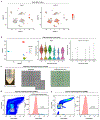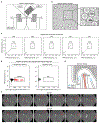Identification of astrocyte regulators by nucleic acid cytometry
- PMID: 36599367
- PMCID: PMC9980163
- DOI: 10.1038/s41586-022-05613-0
Identification of astrocyte regulators by nucleic acid cytometry
Abstract
Multiple sclerosis is a chronic inflammatory disease of the central nervous system1. Astrocytes are heterogeneous glial cells that are resident in the central nervous system and participate in the pathogenesis of multiple sclerosis and its model experimental autoimmune encephalomyelitis2,3. However, few unique surface markers are available for the isolation of astrocyte subsets, preventing their analysis and the identification of candidate therapeutic targets; these limitations are further amplified by the rarity of pathogenic astrocytes. Here, to address these challenges, we developed focused interrogation of cells by nucleic acid detection and sequencing (FIND-seq), a high-throughput microfluidic cytometry method that combines encapsulation of cells in droplets, PCR-based detection of target nucleic acids and droplet sorting to enable in-depth transcriptomic analyses of cells of interest at single-cell resolution. We applied FIND-seq to study the regulation of astrocytes characterized by the splicing-driven activation of the transcription factor XBP1, which promotes disease pathology in multiple sclerosis and experimental autoimmune encephalomyelitis4. Using FIND-seq in combination with conditional-knockout mice, in vivo CRISPR-Cas9-driven genetic perturbation studies and bulk and single-cell RNA sequencing analyses of samples from mouse experimental autoimmune encephalomyelitis and humans with multiple sclerosis, we identified a new role for the nuclear receptor NR3C2 and its corepressor NCOR2 in limiting XBP1-driven pathogenic astrocyte responses. In summary, we used FIND-seq to identify a therapeutically targetable mechanism that limits XBP1-driven pathogenic astrocyte responses. FIND-seq enables the investigation of previously inaccessible cells, including rare cell subsets defined by unique gene expression signatures or other nucleic acid markers.
© 2023. The Author(s), under exclusive licence to Springer Nature Limited.
Conflict of interest statement
Figures














References
-
- Baecher-Allan C, Kaskow BJ & Weiner HL Multiple sclerosis: mechanisms and immunotherapy. Neuron 97, 742–768 (2018). - PubMed
Publication types
MeSH terms
Substances
Grants and funding
- R01 MH130458/MH/NIMH NIH HHS/United States
- R01 ES032323/ES/NIEHS NIH HHS/United States
- K99 NS114111/NS/NINDS NIH HHS/United States
- R01 AI126880/AI/NIAID NIH HHS/United States
- DP2 AI154435/AI/NIAID NIH HHS/United States
- F32 NS101790/NS/NINDS NIH HHS/United States
- WT_/Wellcome Trust/United Kingdom
- U01 AI129206/AI/NIAID NIH HHS/United States
- R00 NS114111/NS/NINDS NIH HHS/United States
- K22 AI152644/AI/NIAID NIH HHS/United States
- R01 ES025530/ES/NIEHS NIH HHS/United States
- R01 AI149699/AI/NIAID NIH HHS/United States
- R21 NS087867/NS/NINDS NIH HHS/United States
- UM1 AI126611/AI/NIAID NIH HHS/United States
- R01 NS129778/NS/NINDS NIH HHS/United States
LinkOut - more resources
Full Text Sources
Medical
Molecular Biology Databases

